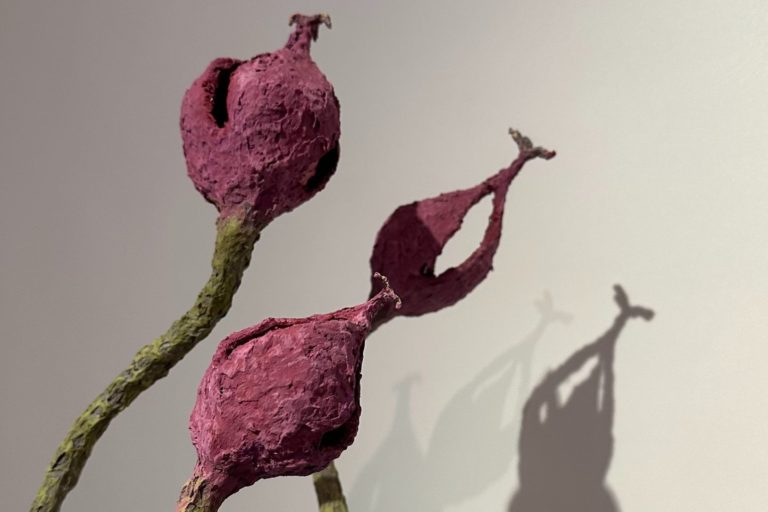
Within the Digital Humanities & Literary Cognition Lab (DHLC), based in the Department of English at Michigan State University, students with diverse skills conduct interdisciplinary research, seeking answers to important literary questions.
More than 30 graduate and undergraduate students with a variety of majors from across the University, including literature, education, neuroscience and computer science, currently work together in the lab, exploring complex concepts at the intersection of humanities and sciences, such as the cognitive intricacy of close reading. Investigating the neural networks activated when we read a novel, a poem, or listen to music means raising big questions. What’s the difference between reading a novel and a sonnet, cognitively speaking? How is fiction-reading like (and unlike) looking at a work of art, listening to music, or watching a film? Why do we enjoy literature so much?

Cofounded by Natalie Phillips, Assistant Professor of English, and Stephen Rachman, Associate Professor of English and Interim Director of the Digital Humanities Program, the DHLC was established in 2012 to research connections between literature and the history of cognition.
“My favorite part about working in this lab is how unique and interdisciplinary it is,” said Karah Smith, a senior with a dual major in English and Psychology and a minor in Digital Humanities. “It’s hard to find this type of work being done anywhere, and we’re fortunate to have it at MSU.”
Students working in the lab currently are helping complete the DHLC’s first major research project where inside an MRI (magnetic resonance imaging) machine, participants highly trained in literary studies read passages of Jane Austen’s Mansfield Park while the research team, led by Phillips, studied cognitive differences between reading for pleasure and close reading.
“It’s hard to find this type of work being done anywhere, and we’re fortunate to have it at MSU.”
Karah Smith
DHLC student researchers also are working on two new research projects: one that explores the kinds of narratives different pieces of music inspire, in which Smith is serving as the undergraduate lead, and another that studies which elements of poetry (and which poems) seem to inspire the most aesthetic pleasure, or displeasure, in readers. Sal Antonucci, a junior majoring in English with a double minor in Philosophy and Digital Humanities, is the undergraduate lead for the “Neuroaesthetics” group working on the poetry study.
“People read poetry, and people have always written poetry, but no one has ever tried to get a scientific explanation of why people like to read and why we care about the humanities,” Antonucci said. “This is one of those core humanities questions that we normally try to answer by ourselves, but in the DHLC, we get to answer it with a large group of people across disciplines.”
In addition to running their individual groups, Antonucci, Smith, and Mohan Gupta, a senior Psychology major and the undergraduate lead for the “Brain Data” group, all work with the DHLC’s undergraduate lab lead, Lana Grasser, a senior studying Neuroscience and Dance, to apply for grants to fund this interdisciplinary research.

“I would say one of the main successes of our groups thus far have been the grants we have received, because we have an intersection where our research is not clearly science and not clearly humanities,” Grasser said. “Being able to convey our research to both audiences, explain how it’s relevant is incredibly difficult; thereby receiving funding is a very big accomplishment.”
The student researchers also have the opportunity to work with other universities. Currently, the DHLC is working on research with teams at New York University and the University of Arkansas.
“Working with other universities is truly a challenge, but it’s a great experience,” Grasser said. “It gives us the opportunity to span throughout the country and across the globe. We really are globally connected.”
“I feel like the one thing that everyone needs in their education is to make it real, and this is where that has happened for us.”
Lana Grasser
Antonucci and Grasser agree that leading research teams, interpreting data, and presenting their results has made a significant impact on their education.
“This experience has taken the theories and ideas that we read about in books and has made them come alive,” Grasser said. “I feel like the one thing that everyone needs in their education is to make it real, and this is where that has happened for us.”
Antonucci added that “it makes me more excited to engage with my professors. Working here has given me an appreciation for education that makes everything more exciting.”
DHLC student researchers will present their work at MSU’s annual University Undergraduate Research and Arts Forum (UURAF) on Friday, April 7, and at the National Conference for Undergraduate Research (NCUR) April 6-8 at the University of Memphis.
Written by Alexandria Drzazgowski, Professional Writing Major


